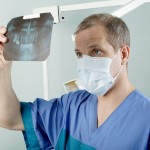
The aim of this study was to investigate whether fixation of fractures of the mandibular angle using miniplates placed through a transbuccal approach resulted in lower infection rates that those placed on the mandibular external oblique ridge using an intra-oral approach.
What did they do
Patients were randomised (by year of birth) to having their mandibular angle fractures treated with an intraorally placed ridge plate, or a plate placed transbuccally. The same plating equipment was used throughout the study with the surgical technique standardised as far as possible and all patients were given a standard perioperative and postoperative antibiotic regimen. The main outcome measure was plate removal because of infection. A range of risk factors were also measured.
What did they find
- 320 patients were enrolled 15, with bilateral angle fractures ( 335 fractures).
- 261 fractures (137 – ridge) (124 – transbuccal) were followed for an average of 6.7 weeks, 70 patients being lost to follow up
- 34 angle plates (13%) were removed for infection and 6 of these (18%) required a further period of fixation
- The transbuccal plate had a significantly lower postoperative infection rate (6/124, 5%) compared with 28/137 (20%) of ridge plates (p = 0.001).
- Smoking adversely affected the healing of angle fractures (p = 0.000).
- Displacement of fractures is related to the infection rate (p = 0.003)
They concluded
transbuccal plating leads to fewer plates being removed for infection than ridge plating in the treatment of angle fractures.
Laverick S, Siddappa P, Wong H, Patel P, Jones DC. Intraoral external oblique ridge compared with transbuccal lateral cortical plate fixation for the treatment of fractures of the mandibular angle: prospective randomised trial. Br J Oral Maxillofac Surg. 2012 Jun;50(4):344-9. Epub 2012 Mar 14.
Comment
While this is a large trial the use of year of birth a method of randomisation means that this study would be classified as at high risk of bias using the Cochrane Collaboration’s risk of bias assessment tool. In addition to the main outcome measure a wide range of risk factors considered to plate removal were also reported. However these is no indication as to whether the trial was adequately powered to assess all of those reported.

please send pdf of transbuccal trocar